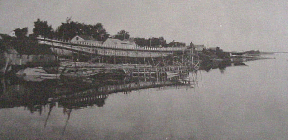 |
 |
 |
 |
 Alexander MacKenzie
was born in 1796, in the village of Contin (near Dingwall) in the northern
Highlands of Scotland. In 1808, at the age of 12, in 1808, he emigrated
to Pictou, following his older brothers to the New world after their parents'
deaths in Scotland. Unlike his eldest brother Donald, who farmed at Four
Mile Brook for the remainder of his life, Alexander apprenticed himself
in commerce in Pictou until the opportunity arose for him to take over
the business of Robert MacKay, a lumber and general merchant in River John.
MacKay was one of many who succumbed, in 1825, to the widespread economic
depression from which there had been no relief since the end of the Napoleonic
Wars. Alexander MacKenzie
was born in 1796, in the village of Contin (near Dingwall) in the northern
Highlands of Scotland. In 1808, at the age of 12, in 1808, he emigrated
to Pictou, following his older brothers to the New world after their parents'
deaths in Scotland. Unlike his eldest brother Donald, who farmed at Four
Mile Brook for the remainder of his life, Alexander apprenticed himself
in commerce in Pictou until the opportunity arose for him to take over
the business of Robert MacKay, a lumber and general merchant in River John.
MacKay was one of many who succumbed, in 1825, to the widespread economic
depression from which there had been no relief since the end of the Napoleonic
Wars.
Alexander was preceded in the shipbuilding business by his brother-in-law, the Honorable Alexander Campbell of Tatamagouche. They had married two Archibald sisters from Truro. The two Alexanders consulted each other frequently. The first vessel on record to be built by Alexander MacKenzie was the "Lucy," in 1828. The next record is of a brigantine of 101 tons, launched in 1834 and named "Eliza." The "Charles," a barque of 519 tons, was launched in 1835 and named after Alexander's eldest son, born the preceding year. In the same year, two other vessels of over 500 tons were launched at River John, one by George Smith of Pictou, and the other by Kenneth MacLean. Neither of these two builders survived long into the following decade. Thomas Archibald, Alexander's second son, was first given the command of a brig at the age of 18. He sailed the barque "Minnie Gordon" (built in River John for Peter Crerar) before taking command of the "David Cannon," launched from the MacLennan yard. In 1870 Captain Thomas offered his services to a steamship company, and never again sailed a wooden vessel. Although Archibald, the youngest of Alexander MacKenzie's sons, had been to sea as a very young man, that life did not appeal to him as it did to his brothers. At 28 he went into partnership with Captain James Lauder, establishing the firm of MacKenzie and Lauder, which built four vessels between 1876 and 1878. One of these ships, the "Aspotagan," one of these ships, has been credited to Charles MacLennan. In 1896 Captain Lauder had told MacLennan, half in jest, that he could build him a ship for forty dollars a ton, a very low figure for the time. Unexpectedly MacLennan accepted the offer, and MacKenzie and Lauder built the ship, knowing that they would make no money from it. In 1879 Lauder left for the United States and the partnership was dissolved. Archibald continued to build ships on his own, of a progressively higher tonnage until the achievements of the River John yards reached their height with the "Warrior" and the "Caldera." Archibald continued to build even after the second James Kitchin had ceased, but his vessels were smaller and of different purpose. Following the accident at the launch of the "Argentina," he turned the shipyard over to his nephew, Charles H. MacLennan, who launched the barque "Gazelle" in 1891, the last square rigged vessel built in River John. From thereon all were schooners. For 15 years, from the turn of the century until the first World War, the shipyards of River John were empty. The War revived the demand for new shipping of any type, wooden sailing vessels included. Although Archibald MacKenzie was then almost seventy years of age, and there were only a few ship's carpenters with the necessary knowledge and skills remaining in the village, he began to build a new ship, the "Cambrai," on the site of the old Kitchin shipyard. A new company, the MacKenzie Shipping Co., had been formed, with shareholders from Halifax, Lunenburg and Antigonish. The newspapers spoke optimistically of the industry's revival, but as the War ended soon afterwards, and with it the demand for ships, this was not to be. (Compiled by Sarah Hockin) |
